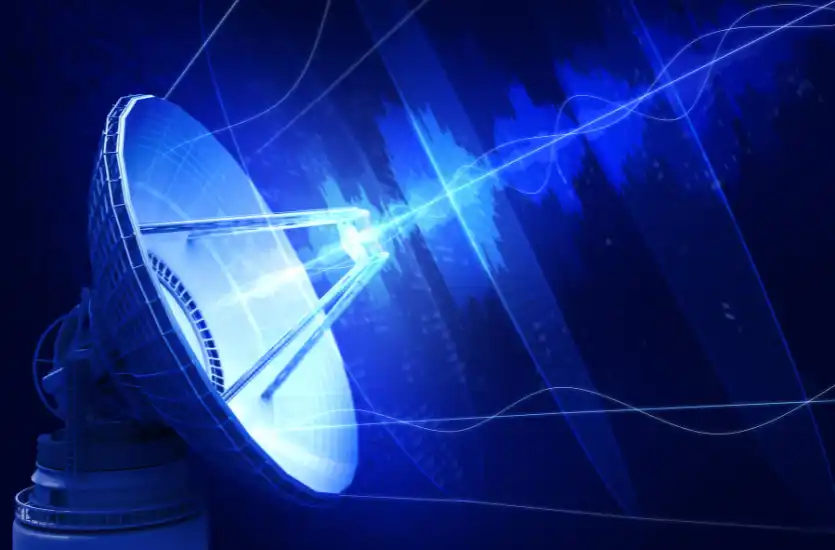Have you ever noticed how the range and clarity of your two-way radio can change depending on where you are? Whether you’re in the middle of an open field or navigating through a crowded urban environment, the way signals travel—or propagate—plays a sizeable role in communication.
Signal propagation is the path of electromagnetic waves from a transmitter to a receiver, moving through mediums like air, cables, or fiber optics. Along the way, these signals encounter various challenges, such as reflection, diffraction, and absorption, affecting their strength and clarity. If your business relies on two-way radios, understanding these principles can help optimize communication.
In this article, we’ll explain signal propagation, the factors that influence it, and how to improve radio range for reliable performance, no matter the environment.
What is Signal Propagation?
You likely understand what a signal is—whether it’s a sound, a message, or a communication in transit. But propagation? That’s a big word. Simply explained, signal propagation is the movement of electromagnetic waves from a transmitter to a receiver. It describes how the energy of the signal travels through a medium, such as air, cables, or fiber optics, to reach its destination.
Think of it like dropping a pebble into a still pond. The ripple created by the pebble expands outward, carrying energy across the water. Similarly, electromagnetic waves spread from a source, such as a radio transmitter, traveling through the medium around them until they reach a receiver, like a two-way radio.
Types of Media
The medium through which a signal moves significantly influences how it behaves:
- Air: Signals travel freely but are subject to environmental interference, such as buildings, trees, or weather conditions.
- Cables: Offer a controlled path for signals, reducing external disruptions, often used in wired communications.
- Fiber Optics: Allow signals to move at high speeds with minimal loss, typically used in advanced data communication systems.
Each medium has unique characteristics, much like different types of terrain impact how water flows. Understanding these characteristics helps us grasp why signals may experience changes in strength or quality depending on their surroundings.
What Influences Signal Propagation?
Think of the last time you had to get somewhere. You got in your car, mapped out your route, and hoped for a quick trip. But various obstacles came up along the way—stop lights, slow speed limits, traffic jams, or construction zones. Each of these slowed your progress, delayed your arrival, or required you to take an alternate path.
Similarly, when a signal travels from a transmitter to a receiver, it encounters its own set of obstacles. These factors can change the way the signal behaves, impacting its ability to deliver a clear and consistent communication path. For two-way radios, these challenges can mean the difference between flawless conversations or choppy, unreliable messages.
Here are some common factors that influence signal propagation and how they impact two-way radio communication:
- Reflection: Signals bounce off surfaces like walls, buildings, or other structures. Urban areas with high-rise buildings can cause signals to reflect multiple times, creating interference or “dead spots.”
- Diffraction: Signals bend around obstacles, such as hills or large structures. This bending allows two-way radios to maintain communication even in rugged terrains where line-of-sight is obstructed.
- Absorption: Materials like concrete, foliage, or water weaken signals as they pass through. Indoor communication can be more challenging because walls and other materials absorb much of the signal’s energy.
- Scattering: Small objects, such as raindrops, dust, or even snow, can disrupt signals by breaking them into smaller fragments. Two-way radios may experience static or reduced clarity in extreme weather conditions.
- Path Loss: The natural weakening of a signal’s strength as it travels over a long distance. Even in open areas, radio range decreases as the signal moves farther from the transmitter.
Understanding these influences is important for improving two-way radio performance. Whether working in urban, rural, or extreme environments, knowing what can get in the way of communications can help you find solutions to maintain strong connections and make sure your flow of information is not disrupted.

Types of Signal Propagation in Radio Communication
The way signals travel depends on their propagation type. Different propagation methods allow signals to reach their destinations depending on the conditions. Understanding these types helps explain why some radio signals perform better in open areas, while others handle rugged terrain or long distances more effectively.
- Line-of-Sight (LOS): This occurs when signals travel directly between the transmitter and receiver without interference. It works best in open spaces or flat terrains, such as parks or large warehouses, where no obstacles block the path.
- Ground Wave Propagation: Signals follow the curvature of the Earth, making this type ideal for medium-range communication. This is commonly used in applications like field operations or rural settings.
- Sky Wave Propagation: Signals reflect off the ionosphere, allowing them to cover long distances. This type is often used in emergency or military communication when extensive coverage is needed.
- Tropospheric Propagation: In this case, signals bounce within the atmosphere, extending their range. It’s beneficial for communication across slightly longer distances than what ground waves can reach.
Environmental and Human Factors Impacting Radio Range
From construction sites to emergency services, two-way radios offer clear and dependable communication. These tools are super important for keeping teams connected, but their performance can vary depending on environmental and external factors.
For instance, an urban setting with high-rise buildings, such as those in downtown Miami creates challenges for signal propagation due to obstacles like walls and dense infrastructure. In contrast, rural areas might offer fewer barriers, but uneven terrain, trees, and natural features can still interfere with signal strength.
Weather conditions can also impact radio communication. Rain, snow, and the high humidity that Florida is known for can weaken radio waves. Locations such as Davie, Fort Pierce, and Sunrise, for example, often experience high levels of humidity, which can reduce signal clarity and range.
Human-made interference is another challenge—devices operating on similar frequencies can create static or disrupt transmissions altogether.
Finally, antenna positioning and height play a significant role. Placing antennas higher or in open areas can improve signal reach, especially in environments where obstacles or interference are present.
Improving Signal Propagation for Two-Way Radios
Regardless of your industry, you want to prioritize flawless communication. The last thing you want is to miss a deadline because important information couldn’t get from point A to point B in a timely manner. That’s why taking some steps to improve your two-way radio signal propagation can be so helpful.
Here are some things to keep in mind if you are experiencing signal issues.
- Use of Repeaters: Repeaters are devices that amplify and retransmit signals, extending their range and improving clarity across large coverage areas. These are especially useful for teams spread across wide or multi-level locations.
- Frequency Choices: Choosing the right frequency for your environment can make a big difference. VHF (Very High Frequency) performs better in open areas with minimal obstacles, while UHF (Ultra High Frequency) is more effective in dense environments, such as urban settings or inside buildings.
- Optimized Antenna Design: Using antennas designed for specific situations—such as those suited for long distances or high obstructions—can improve communication. Antenna placement also plays a role, so positioning them in open and elevated locations is often beneficial.
- Digital Radios vs. Analog: Digital radios handle interference better than analog systems. They provide clearer communication and are less likely to pick up static or background noise, making them a smart choice for environments with high levels of activity.
- Proper Maintenance: Regularly maintaining radios and their accessories, such as batteries and antennas, helps keep them in good working condition. Routine checks can identify wear and tear that might otherwise affect performance.

Stay Connected with Motorola Two-Way Radio Solutions From EMCI Wireless
Signal propagation is the foundation of two-way radio communication. It describes how electromagnetic waves travel from a transmitter to a receiver. Understanding the factors that affect this process—like reflection, diffraction, absorption, scattering, and path loss—helps explain why radio performance can vary in different environments. These challenges can be addressed through repeaters, frequency selection, optimized antennas, digital radios, and proper maintenance.
By taking the time to understand and address the factors influencing radio signals, you can create more dependable communication systems for your team, no matter the setting. But there is no need to be a radio propagation expert—EMCI Wireless, Florida’s premier Motorola channel partner, is here to help. We excel in transforming communication systems by expertly designing, supporting, maintaining, and optimizing them for long-term, reliable performance.
If you’re looking for guidance or advanced equipment to improve your radio communication, visit EMCI Wireless or contact our experts today. Let us help you build a system that keeps your team connected when it matters most. Schedule a free consultation today.

